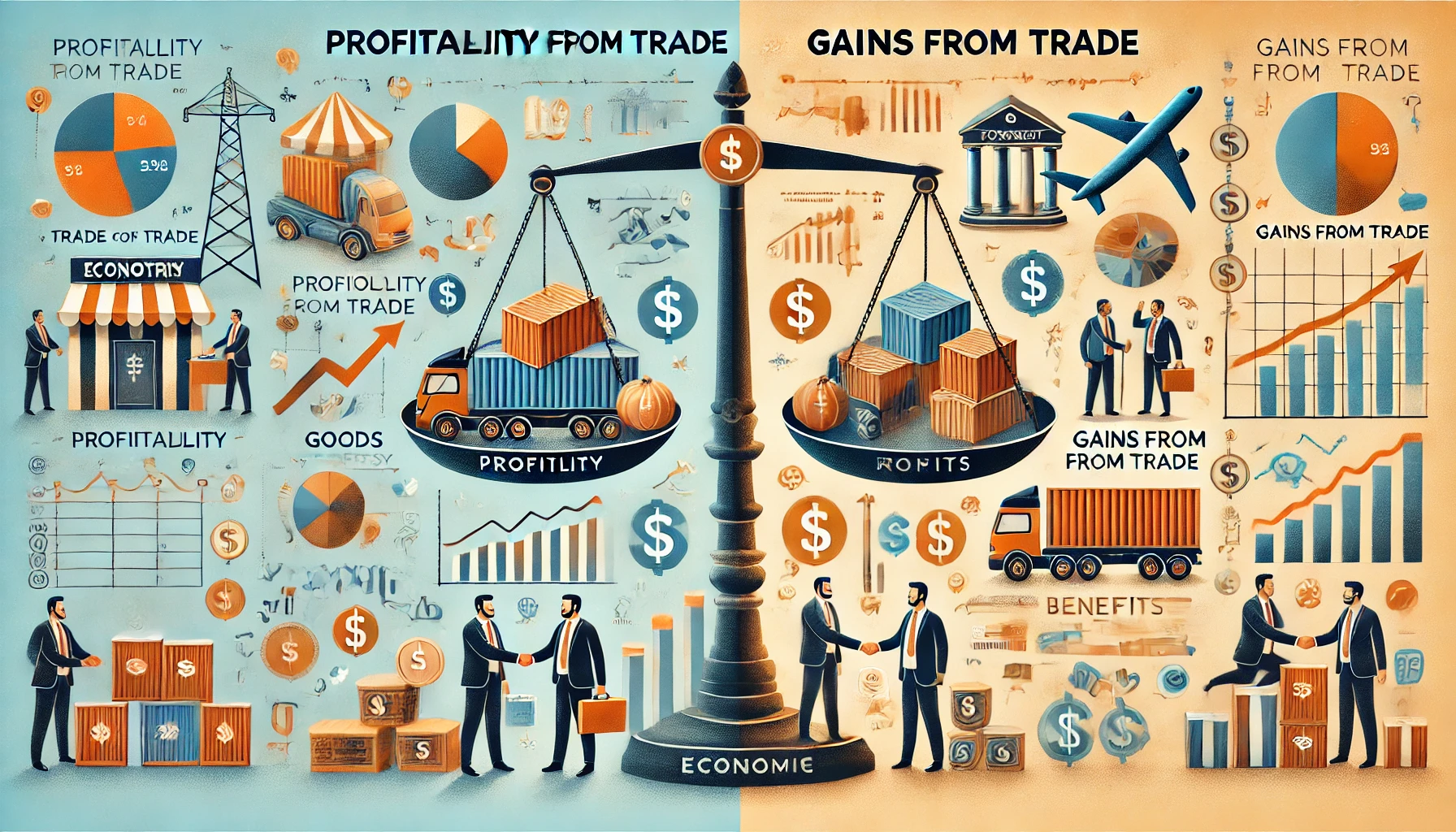Profitability from Trade:
Definition: Profitability from trade refers to the financial gains or profits that businesses, individuals, or countries derive from engaging in trade. It focuses on the net financial returns resulting from trading activities, where the revenue generated from selling goods and services exceeds the costs of production and trading.
Key Characteristics:
- Focus on Financial Returns: Profitability emphasizes the financial outcome of trade, specifically the difference between the costs of producing and selling goods or services and the revenue earned from those sales.
- Business-Centric: Primarily concerned with the profit margins of businesses and how effectively they can leverage trade to enhance their bottom line.
- Short-Term and Long-Term: Profitability can be analyzed both in the short-term (quarterly or annually) and long-term, depending on the business strategy and market conditions.
- Economic Indicator: Used as an indicator of a business’s or country’s economic health, reflecting the efficiency and effectiveness of trading practices.
Examples:
- A manufacturing company increasing its profit margins by sourcing cheaper raw materials from abroad and selling finished goods at competitive prices.
- A country exporting high-demand commodities like oil or technology products, generating significant foreign exchange and increasing national wealth.
Gains from Trade:
Definition: Gains from trade refer to the overall benefits that countries, businesses, or individuals experience as a result of participating in trade. These benefits can include increased efficiency, access to a wider variety of goods and services, economic growth, improved living standards, and technological advancement.
Key Characteristics:
- Broad Scope: Gains from trade encompass a wide range of benefits beyond just financial profits, including social, economic, and technological improvements.
- Long-Term Perspective: Gains from trade often focus on long-term outcomes, such as sustained economic growth, development, and increased global competitiveness.
- Inclusive: Gains from trade consider the overall welfare of the economy, including how trade impacts consumers, workers, and different sectors of the economy.
- Economic and Social Indicator: Used to assess the overall impact of trade on a country’s or economy’s development, considering factors like efficiency, resource allocation, consumer choice, and technological progress.
Examples:
- A country benefiting from trade by specializing in industries where it has a comparative advantage, leading to higher productivity and economic growth.
- Consumers enjoying a greater variety of goods and services at lower prices due to increased international competition and trade.
Key Differences:
| Aspect | Profitability from Trade | Gains from Trade |
| Focus | Financial returns and profit margins from trade activities. | Overall benefits from trade, including economic, social, and technological gains. |
| Scope | Narrow focus on the financial performance of businesses or specific sectors. | Broad focus on the overall economy, considering multiple factors such as efficiency, consumer welfare, and economic development. |
| Perspective | Short-term and long-term financial outcomes. | Long-term economic and social outcomes, including sustainability and inclusivity. |
| Indicators | Profit margins, return on investment, revenue growth. | GDP growth, improved living standards, technological advancement, increased consumer choice. |
| Beneficiaries | Primarily businesses, investors, and shareholders. | Entire economy, including consumers, workers, and governments. |
| Measurement | Quantified in monetary terms (profits, margins, etc.). | Includes both quantitative and qualitative measures (economic growth, social welfare, access to goods and services). |
| Impact on Economy | Reflects the economic health of businesses and specific sectors. | Reflects the overall economic health and development of a country or region. |
| Policy Focus | Policies aimed at enhancing business profitability, such as tax cuts or trade incentives. | Policies aimed at maximizing overall welfare from trade, including trade agreements, infrastructure development, and social policies. |
Key Takeaways:
- Narrow vs. Broad Focus:
- Profitability from Trade is primarily concerned with the financial success of businesses and industries, focusing on how trade impacts profit margins and financial returns.
- Gains from Trade have a broader focus, considering the overall benefits to the economy, society, and individual well-being, including factors like economic growth, technological progress, and consumer welfare.
- Short-Term vs. Long-Term:
- Profitability from Trade can be assessed in both short-term and long-term financial terms, emphasizing immediate financial outcomes.
- Gains from Trade typically emphasize long-term economic and social benefits, focusing on sustained improvements in welfare and economic development.
- Business-Centric vs. Economy-Wide:
- Profitability from Trade is more business-centric, focusing on how trade affects the financial performance of individual businesses or industries.
- Gains from Trade consider the economy-wide impact, including how trade influences national economic growth, living standards, and global competitiveness.
- Measurement and Impact:
- Profitability from Trade is measured in monetary terms, such as profits, revenue, and return on investment.
- Gains from Trade encompass a mix of quantitative (e.g., GDP growth) and qualitative measures (e.g., consumer satisfaction, technological progress).
Conclusion: While profitability from trade focuses on the financial benefits derived by businesses and industries from engaging in trade, gains from trade encompass a broader range of economic, social, and technological benefits that enhance overall economic welfare. Both concepts are important, but they serve different purposes and are measured differently. Profitability from trade is crucial for understanding the financial health of businesses and their capacity to compete in global markets, whereas gains from trade provide a more comprehensive view of how trade contributes to the long-term development and well-being of an economy. Understanding both concepts is essential for making informed decisions in business strategy and economic policy

